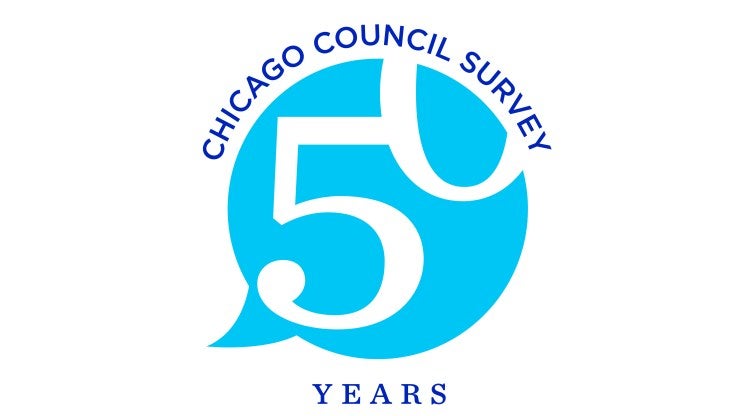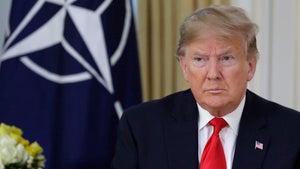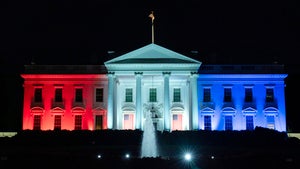Solid majorities of Democrats and Independents think the United States should consult with allies before making major foreign policy decisions, but only four in 10 Republicans agree.
When US President Donald Trump reclaimed the White House in January 2025, US allies had some idea what to expect given his skepticism of US global partnerships. His America First agenda would call on them to increase defense spending, take on more responsibility for their own defense, and address long-standing trade imbalances. Even so, the change has been dramatic following the alliance-forward approach from the Biden White House. Allies now face challenging demands and conditions for the US security commitment and additional pressures to absorb US tariffs, align with US policies on China, and curtail oil purchases from Russia.
Data from the 2025 Chicago Council Survey, fielded July 18-30, 2025, show that while Trump administration officials have questioned the benefits of US alliances, the American public is much more convinced of their intrinsic value. For more than a decade, maintaining alliances has been seen as one of the most effective ways to realize US foreign policy goals. In addition, the largest majorities yet believe that US alliances in Europe, Asia, and the Middle East benefit the United States and its allies. These data suggest that if alliance relations are undercut by US policy, that shift is not being driven by US public discontent.
Key Findings
- Far more Americans think the United States should mainly make important foreign policy decisions with major allies (60%) versus on its own (21%).
- Large majorities consider maintaining US alliances (91%) and superior US military power (85%) to be effective ways to achieve US foreign policy goals, but this year, maintaining alliances edges out military power as a “very” effective tool (55% vs. 48% military).
- The highest levels of Americans yet recorded in Chicago Council polling think US security alliances in Europe (68%), Asia (72%), and the Middle East (67%) benefit the United States alone or the United States along with its regional allies.
- Sixty-two percent of Americans are at least somewhat confident that if the United States is attacked, European allies would come to America’s defense; 51 percent say the same about US allies in Asia.
Alliances Considered Most Effective Way to Achieve US Foreign Policy Goals
In his first term in the Oval Office, Trump perceived US allies as free riders, taking advantage of the US security guarantee while not spending enough to maintain their own defenses. Trump’s preference that allies contribute more to their own security by paying a larger share is not that different from US presidents before him. But unlike previous presidents, he has threatened to undercut or even terminate US alliances if cost-sharing does not advance. The Trump approach is often described as transactional, taking the view that alliances are undercutting the US economy, and therefore US security guarantees should be linked to allies’ increasing their imports of US goods.
But everyday Americans do not seem to take a similar position. Instead, the American public believes US alliances enhance the country’s position in the world. Maintaining alliances and superior US military capabilities are viewed by the public as the two most effective ways to achieve US foreign policy goals. Almost six in 10 Americans overall say maintaining US alliances is a very effective way to realize foreign policy aims (55%), one of the highest readings since the Chicago Council Survey began asking the question just over a decade ago (see appendix table 1). In fact, this year, more Americans consider alliances a very effective approach than consider superior military power very effective (48%).
While self-described Democrats are the most convinced about the effectiveness of alliances (64%, an all-time high), a majority of Republicans agrees (53%, an all-time high), along with about half of Independents (48%).
In an open-ended question included in the survey, several respondents discussed how alliances help to increase American power. “There is strength in numbers. We need allies to protect us from dangerous countries who wish us harm and hate us,” notes one woman, age 61, and a self-described Independent. Another male, age 76 and a Republican supporter, continued on this theme, especially in terms of deterring potential aggressors: “Being a part of NATO and having Pacific and Middle Eastern allies gives us strength against aggressive countries.”
One respondent, a 38-year-old woman who supports the Democrats, refers to the deterrent aspect of alliances and the risks of withdrawing from active engagement with them: “The world will keep moving with or without the United States and we will not continue to be respected and/or feared without our alliances and active presence around the world. Stepping back doesn’t mean “America First” it means that China or another country will become the most powerful and put us at risk.”
But some survey respondents have complaints about the burden of alliances. One woman, age 56, who opts to describe her political affiliation as “other” states, "We are spending entirely too much on spending to protect other countries when we can't even protect or provide for our own citizens." Another 71-year-old male, who describes himself as an Independent, puts forth, “We have commitments to our allies as long as they reciprocate. [I am] . . . sick of being suckered paying for freeloader countries that think we should spend our money [for their security].”
Majorities Say United States Should Consult with Allies
Like some previous administrations, the Trump administration has at times sidelined US allies in key negotiations while ignoring the conflict that may create for US partners. Most Americans, however, think the United States should mainly make important foreign policy decisions with major allies, the highest level recorded on this question in 50 years (60% in 2025, 56% in 2020, and 51% in 1974). By contrast, just two in 10 think the United States should make these decisions unilaterally (21%).
While Democrats and Republicans both consider alliances to be effective, there is partisan division on whether allies should be consulted or whether the United States should make decisions on its own. Solid majorities of Democrats (74%) and Independents (60%) agree the United States should consult with allies, and both readings are at their highest levels yet (see appendix table 2). A plurality of Republicans endorses consultations with allies (43%), similar to 2020 (45%) but lower than five decades ago (when 54% agreed, on par with Democrats). A similar proportion of Republicans prefers unilateral decision-making (38%), similar to previous levels.
Across the Political Spectrum, Majority Support for Transatlantic Alliance
Relations between the United States and Europe during Trump’s second term have been tumultuous. At the June NATO summit in the Netherlands, European allies pledged to increase their defense spending in order to meet Trump’s condition for continuing the US commitment to transatlantic collective defense. In addition, Trump reversed the Biden administration’s military and economic support for Ukraine and rolled out the red carpet for Russian President Vladimir Putin in Alaska, rattling European allies. There was so much concern about the Alaska meeting that it prompted key European Union (EU) leaders to join Ukrainian President Volodymyr Zelenskyy for an emergency meeting at the Oval Office. Then in September, at the United Nations General Assembly, Trump surprised allies again, stating on social media that Ukraine could win back all of its territory from Russia and that he believed NATO allies should shoot down Russian aircraft that breach their airspace.
In contrast to the unpredictability of Trump’s positions, the US public has been fairly consistent in their support of transatlantic ties. More Americans now than in 2023 say US security alliances in Europe benefit the United States either alone or along with its allies (a combined 68%, up from a combined 64% in 2023). As has been the case since 2017, Democrats are the most emphatic NATO supporters (81%), though a full two-thirds of Independents also sense mutual benefits or benefits to the United States (67%). Republican opinion has fluctuated a bit since 2017, dipping to 50 percent in 2023 and now back to a majority who see mutual benefits and benefits to the United States (57%).
When asked about the US commitment to NATO specifically in May 2025, a combined three in four Americans (73%) favored maintaining (48%) or increasing (25%) US support for NATO, similar to readings going back to 2002. As has been true in Council polls since 1998, Democrats today appear to be the most enthusiastic backers of the NATO alliance, with nine in 10 supporting maintaining or increasing the US commitment (91%). Seven in 10 Independents (70%) feel the same way, similar to their views over the past two decades.
While a majority of Republicans also endorse the US commitment to NATO (59%), this share dropped 9 percentage points since last year to its lowest level yet on record for Chicago Council surveys. The combination of declining Republican support and growing Democratic support led to a record 32-percentage-point difference between partisan support.
Cross-Partisan Support for Transpacific Alliances
Given the primacy of US competition with China, US allies in Asia may have thought they would receive relatively more positive treatment from the new US administration than have their European counterparts. But instead, Asian allies find themselves facing similar demands to get on board with US policy toward China, increase their defense budgets, and absorb the economic consequences of Trump’s tariff policies.
Here too, the American public has been quite consistent in their appreciation of US allies in East Asia and, in fact, have grown even more positive toward these alliances. Seven in 10 Americans say US alliances in East Asia benefit the United States as well as the United States and its allies (72%), higher than any reading since 2017. Larger majorities across the political spectrum than ever before endorse these partnership, including Democrats (74%), Independents (72%), and Republicans (68%).
Highest Support Yet for Alliances in the Middle East
The humanitarian crisis in Gaza and Israel’s conduct in the war against Hamas—including launching a strike against Hamas leaders in Qatar—have complicated the United States’ relationships with other regional actors, including Saudi Arabia and Qatar itself, and tested its ability to balance competing priorities in the region. Against this backdrop, public views of US alliances in the Middle East have become especially relevant.
American support for US alliances in the Middle East is now higher than it has ever been, with large increases among Republicans and Independents over the past year—perhaps in response to US support for Israel in the war in Gaza. Two-thirds of Americans across the board say US alliances in the Middle East are beneficial to the United States itself and both the United States and its Mideast allies.
Americans Tend to Believe Alliances Are a Two-Way Street
A key commitment undergirding US security alliances is the guarantee to defend a fellow alliance member if it is attacked. Americans seem to trust that US allies in Europe and Asia can be counted upon. When asked to gauge their confidence in regional allies defending the United States if it were attacked, six in 10 are at least somewhat confident European allies would (62%). Seven in 10 Democrats place trust in European allies (69%), compared to six in 10 Republicans (60%) and Independents (56%).
When asked about Asian allies, half of the US public expresses trust that they will come to America’s defense (51%). Here too, Democrats are slightly more confident (54%) in Asian allies than Republicans and Independents (49% each).
Conclusion
According to Mireya Solís of the Brookings Institution, a “testament to the clout of American alliances is how much US rivals chafe at them and seek their erosion.” The American public also seems to understand the value of US security alliances in the face of geopolitical competition; in fact, they seem to signal a growing appreciation of them in this current moment.
Appendix Table 1. Top Two Most Effective US Foreign Policy Approaches
How effective do you think each of the following approaches are to achieving the foreign policy goals of the United States—very effective, somewhat effective, not very effective, or not effective at all?
| Overall | Republican | Democrat | Independent | R-D Gap | |
|---|---|---|---|---|---|
| 2014 | 38 | 37 | 41 | 34 | -4 |
| 2015 | 32 | 31 | 37 | 26 | -6 |
| 2016 | 40 | 40 | 45 | 34 | -5 |
| 2017 | 49 | 43 | 56 | 47 | -13 |
| January 2020 | 55 | 56 | 60 | 51 | -4 |
| 2022 | 54 | 50 | 62 | 49 | -12 |
| 2024 | 46 | 41 | 56 | 40 | -15 |
| 2025 | 55 | 53 | 64 | 48 | -11 |
| Overall | Republican | Democrat | Independent | R-D Gap | |
|---|---|---|---|---|---|
| 2014 | 49 | 51 | 49 | 49 | 2 |
| 2015 | 52 | 51 | 52 | 54 | -1 |
| 2016 | 50 | 48 | 49 | 52 | -1 |
| 2017 | 42 | 48 | 35 | 44 | 13 |
| January 2020 | 35 | 41 | 30 | 37 | 11 |
| 2022 | 39 | 43 | 33 | 41 | 10 |
| 2024 | 43 | 49 | 36 | 44 | 13 |
| 2025 | 36 | 42 | 27 | 39 | 15 |
| Overall | Republican | Democrat | Independent | R-D Gap | |
|---|---|---|---|---|---|
| 2014 | 9 | 9 | 7 | 11 | 2 |
| 2015 | 11 | 12 | 7 | 13 | 5 |
| 2016 | 7 | 9 | 4 | 9 | 5 |
| 2017 | 7 | 7 | 6 | 7 | 1 |
| January 2020 | 5 | 3 | 4 | 7 | -1 |
| 2022 | 6 | 6 | 4 | 8 | 2 |
| 2024 | 8 | 8 | 5 | 10 | 3 |
| 2025 | 7 | 4 | 7 | 9 | -3 |
| Overall | Republican | Democrat | Independent | R-D Gap | |
|---|---|---|---|---|---|
| 2014 | 3 | 1 | 2 | 4 | -1 |
| 2015 | 4 | 4 | 2 | 6 | 2 |
| 2016 | 2 | 2 | 1 | 3 | 1 |
| 2017 | 1 | 0 | 2 | 2 | -2 |
| January 2020 | 3 | 1 | 5 | 4 | -4 |
| 2022 | 1 | 1 | 0 | 2 | 1 |
| 2024 | 3 | 1 | 2 | 6 | -1 |
| 2025 | 2 | 1 | 1 | 3 | 0 |
| Overall | Republican | Democrat | Independent | R-D Gap | |
|---|---|---|---|---|---|
| 2012 | 42 | 50 | 40 | 39 | 10 |
| 2014 | 47 | 54 | 43 | 45 | 11 |
| 2015 | 40 | 50 | 37 | 34 | 13 |
| 2016 | 47 | 61 | 43 | 42 | 18 |
| 2017 | 47 | 66 | 38 | 43 | 28 |
| January 2020 | 53 | 80 | 39 | 46 | 41 |
| 2022 | 51 | 66 | 42 | 48 | 24 |
| 2024 | 48 | 63 | 42 | 42 | 21 |
| 2025 | 48 | 75 | 34 | 41 | 41 |
| Overall | Republican | Democrat | Independent | R-D Gap | |
|---|---|---|---|---|---|
| 2012 | 42 | 40 | 44 | 41 | -4 |
| 2014 | 37 | 34 | 42 | 37 | -8 |
| 2015 | 40 | 35 | 45 | 40 | -10 |
| 2016 | 38 | 30 | 43 | 39 | -13 |
| 2017 | 37 | 29 | 42 | 38 | -13 |
| January 2020 | 35 | 19 | 42 | 39 | -23 |
| 2022 | 36 | 27 | 43 | 36 | -16 |
| 2024 | 36 | 27 | 43 | 37 | -16 |
| 2025 | 37 | 21 | 46 | 42 | -25 |
| Overall | Republican | Democrat | Independent | R-D Gap | |
|---|---|---|---|---|---|
| 2012 | 12 | 9 | 13 | 13 | -4 |
| 2014 | 12 | 10 | 12 | 15 | -2 |
| 2015 | 13 | 9 | 12 | 17 | -3 |
| 2016 | 11 | 7 | 12 | 14 | -5 |
| 2017 | 12 | 4 | 15 | 15 | -11 |
| January 2020 | 7 | 0 | 11 | 9 | -11 |
| 2022 | 10 | 6 | 12 | 12 | -6 |
| 2024 | 10 | 8 | 11 | 13 | -3 |
| 2025 | 10 | 3 | 16 | 11 | -13 |
| Overall | Republican | Democrat | Independent | R-D Gap | |
|---|---|---|---|---|---|
| 2012 | 3 | 1 | 2 | 5 | -1 |
| 2014 | 2 | 2 | 2 | 3 | 0 |
| 2015 | 6 | 4 | 4 | 8 | 0 |
| 2016 | 3 | 2 | 2 | 4 | 0 |
| 2017 | 3 | 1 | 4 | 4 | -3 |
| January 2020 | 4 | 0 | 6 | 4 | -6 |
| 2022 | 2 | 1 | 2 | 4 | -1 |
| 2024 | 5 | 2 | 3 | 8 | -1 |
| 2025 | 3 | 1 | 3 | 6 | -2 |
Appendix Table 2: Multilateral Decision Making
Do you feel that the United States should mainly make its major foreign policy decisions on its own, or do you feel it should mainly consult with its major allies before making major foreign policy decisions?
| Overall | Republican | Democrat | Independent | R-D Gap | |
|---|---|---|---|---|---|
| 1974 | 38 | 36 | 38 | 40 | -2 |
| 2020 | 24 | 36 | 14 | 24 | 22 |
| 2025 | 21 | 38 | 10 | 17 | 28 |
| Overall | Republican | Democrat | Independent | R-D Gap | |
|---|---|---|---|---|---|
| 1974 | 51 | 54 | 53 | 50 | 1 |
| 2020 | 56 | 45 | 67 | 56 | -22 |
| 2025 | 60 | 43 | 74 | 60 | -31 |
| Overall | Republican | Democrat | Independent | R-D Gap | |
|---|---|---|---|---|---|
| 1974 | 11 | 10 | 8 | 10 | 2 |
| 2020 | 19 | 19 | 18 | 19 | 1 |
| 2025 | 19 | 19 | 15 | 21 | 4 |
This analysis is primarily based on data from the 2025 Chicago Council Survey of the American public on foreign policy, a project of the Lester Crown Center on US Foreign Policy.
The 2025 Chicago Council Survey was conducted July 18–30, 2025, by Ipsos using its large-scale, nationwide, online research panel (KnowledgePanel) in English and Spanish among a weighted national sample of 2,148 adults 18 or older living in all 50 US states and the District of Columbia. The margin of sampling error for the full sample is ±2.2 percentage points, including a design effect of 1.07.
Partisan identification is based on how respondents answered a standard partisan self-identification question: “Generally speaking, do you think of yourself as a Republican, a Democrat, an Independent, or what?”
The data for the total sample were weighted to adjust for gender by age, race/ethnicity, education, Census region, metropolitan status, and household income using demographic benchmarks from the 2024 March Supplement of the Current Population Survey (CPS). The specific categories used were:
- Gender (Male, Female) by Age (18–29, 30–44, 45-59 and 60+)
- Race/Hispanic Ethnicity (White Non-Hispanic, Black Non-Hispanic, Other, Non-Hispanic, Hispanic, 2+ Races, Non-Hispanic)
- Education (Less than High School, High School, Some College, Bachelor or Higher)
- Census Region (Northeast, Midwest, South, West)
- Metropolitan status (Metro, Non-Metro)
- Household Income (Under $25,000, $25,000–$49,999, $50,000–$74,999, $75,000–$99,999, $100,000–$149,999, $150,000+)
The 2025 Chicago Council Survey is made possible by the generous support of the Crown family and the Korea Foundation.






Related Content
 Defense and Security
Defense and Security
Roughly six in 10 favor using US troops if Russia were to invade a NATO ally like Poland or Latvia, Lithuania and Estonia.
 Public Opinion
Public Opinion
The gap between Democrats and Republicans on America's NATO commitment has reached an all-time high in Council polling dating back to 1974.
 US Foreign Policy
US Foreign Policy
In a 21-point shift, 51 percent of Republicans now favor providing US military aid to Kyiv.
 US Foreign Policy
US Foreign Policy
Results and analysis of the Council's annual survey of American views on foreign policy.
